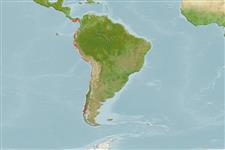Bivalvia |
Cardiida |
Solecurtidae
Environment: milieu / climate zone / depth range / distribution range
Ecology
Benthic; depth range 0 - 37 m (Ref. 87801). Subtropical; 9°N - 48°S, 83°W - 70°W
Eastern Pacific: Panama to Chile.
Length at first maturity / Size / Weight / Age
Maturity: Lm ? range ? - ? cm Max length : 7.8 cm SHL male/unsexed; (Ref. 105121)
Abundant in sand (Ref. 122296). It is an infaunal species found in tide pools, sandy, pebbly, muddy and clay substrates from the intertidal area to a depth of 37 meters (Ref. 87801). Subtidal (Ref. 122295). Deep burrower (Ref. 122294). Mainly a filter feeder (Ref. 105122), particularly a suspension feeder (Ref. 105121). It can switch to surface deposit-feeding based on food availability (Ref. 105122).
Life cycle and mating behavior
Maturity | Reproduction | Spawning | Eggs | Fecundity | Larvae
Members of the class Bivalvia are mostly gonochoric, some are protandric hermaphrodites. Life cycle: Embryos develop into free-swimming trocophore larvae, succeeded by the bivalve veliger, resembling a miniature clam.
Aguero, M. 2004 Chile. In Review of the state of world marine capture fisheries management: Pacific Ocean. De Young, C. (ed). 2007. FAO Fisheries Technical Paper 488(1). Rome, FAO. 170 p. (Ref. 82407)
IUCN Red List Status
(Ref. 130435: Version 2025-1)
CITES status (Ref. 108899)
Not Evaluated
Not Evaluated
Threat to humans
Harmless
Human uses
Fisheries: commercial
| FishSource |
Tools
More information
Population dynamicsGrowth
Max. ages / sizes
Length-weight rel.
Length-length rel.
Length-frequencies
Mass conversion
Abundance
Life cycleReproductionMaturityFecunditySpawningEggsEgg developmentLarvae PhysiologyOxygen consumption
Human RelatedStamps, coins, misc.
Internet sources
Estimates based on models
Preferred temperature
(Ref.
115969): 11.3 - 24.3, mean 17.8 (based on 200 cells).
Fishing Vulnerability
Low vulnerability (10 of 100).
